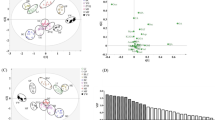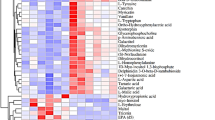Abstract
Pile-fermentation is a critical procedure for producing Chinese dark tea, during which thermophilic microorganisms would play an irreplaceable role. However, there have been little researches on the influences of thermophilic microorganism pile-fermentation (TMPF) in high-temperature of Chinese dark tea. Thus, we conducted high-performance liquid chromatography and nontargeted metabolomic to analyze the non-volatile metabolites of TMPF. Our results discovered that the amounts of ( −)-epigallocatechin gallate, ( −)-epigallocatechin, ( −)-epicatechin gallate, and ( −)-epicatechin were decreased significantly (p < 0.05) after TMPF. By using nontargeted metabolomic analysis, a total of 1733 ion features were detected. KEGG pathway enrichment analysis showed that TMPF had a significant impact on caffeine metabolism. Also, theophylline, 3-methylxanthine, and 1,3,7-trimethyluric acid were increased significantly after TMPF, which suggested that demethylation and oxidation reaction might be the main pathways of caffeine metabolism. This study provides a better understanding of the mechanism of TMPF during high-temperature for Chinese dark tea and lays a foundation for further research.







Similar content being viewed by others
References
Buysse J, Merckx R. An improved colorimetric method to quantify sugar content of plant tissue. Journal of Experimental Botany. 44: 1627–1629 (1993)
Chen CY, Zhang WM, Lv CY, Han BY, Xiong XF, Ge F. Primary study on thermophiles during pile-fermentation of pu-er tea. In: IEEE International Symposium on IT in Medicine and Education, pp. 691–695 (2011)
Cheng LZ, Yang QQ, Chen ZY, Zhang JR, Chen Q, Wang YF. Distinct changes of metabolic profile and sensory quality during Qingzhuan tea processing revealed by LC-MS-based metabolomics. Journal of Agricultural and Food Chemistry. 68: 4955–4965 (2020)
Dai WD, Qi DD, Yang T, Lv HP, Guo L, Zhang Y, Zhu Y, Peng QH, Xie DC, Tan JF, Lin Z. Nontargeted analysis using ultraperformance liquid chromatography-quadrupole time-of-flight mass spectrometry uncovers the effects of harvest season on the metabolites and taste quality of tea (Camellia sinensis L.). Journal of Agricultural and Food Chemistry. 63: 9869–9878 (2015)
Dai WD, Xie DC, Lu ML, Li PL, Lv HP,Yang C, Peng QH, Zhu Y, Guo L, Zhang Y, Tan JF, Lin Z. Characterization of white tea metabolome: Comparison against green and black tea by a nontargeted metabolomics approach. Food Research International. 96: 40–45 (2017)
Dash SS, Gummadi SN. Biodegradation of caffeine by Pseudomonas sp. NCIM 5235. Research Journal of Microbiology. 1: 115–123 (2006)
Deng XJ, Huang GH, Tu Q, Zhou HJ, Li YL, Shi HY, Wu XX, Ren HT, Huang KL, He XY, Xu WT. Evolution analysis of flavor-active compounds during artificial fermentation of Pu-erh tea. Food Chemistry. 357: 129783 (2021)
Drewnowski A, Gomez-Carneros C. Bitter taste, phytonutrients, and the consumer: a review. American Journal of Clinical Nutrition. 72: 1424–1435 (2000)
Guo WL, Zhao MM, Chen QJ, Huang L, Mao Y, Xia N, Teng JW, Wei BY. Citrinin produced using strains of Penicillium citrinum from Liupao tea. Food Bioscience. 28: 183–191 (2019)
Hu S, He C, Li YC, Yu Z, Chen YQ, Wang YM, Ni DJ. Changes of fungal community and non-volatile metabolites during pile-fermentation of dark green tea. Food Research International. 147: 110472 (2021)
Kong XJ. Relativity study on the specific thermophiles dynamic variation with quality in Puer tea pile-fermentation process, (Master). Kunming University of Science and Technology, Kunming (2012).
Li ZY, Feng CX, Luo XG, Yao HL, Zhang DC, Zhang TC. Revealing the influence of microbiota on the quality of Pu-erh tea during fermentation process by shotgun metagenomic and metabolomic analysis. Food Microbiology. 76: 405–415 (2018)
Li Q, Jin YL, Jiang RG, Xu YQ, Zhang YY, Luo Y, Huang JN, Wang KB, Liu ZH. Dynamic changes in the metabolite profile and taste characteristics of Fu brick tea during the manufacturing process. Food Chemistry. 344: 128576 (2021)
Liang YR, Wu Y, Lu JL, Zhang LY. Application of chemical composition and infusion colour difference analysis to quality estimation of jasmine-scented tea. International Journal of Food Science and Technology. 42: 459–468 (2007).
Lin FJ, Wei XL, Liu HY, Li H, Xia Y, Wu DT, Zhang PZ, Gandhi GR, Li HB, Gan RY. State-of-the-art review of dark tea: From chemistry to health benefits. Trends in Food Science & Technology. 109: 126–138 (2021)
Liu Y, Luo LY, Liao CX, Li C, Wang J, Zeng L. Effects of brewing conditions on the phytochemical composition, sensory qualities and antioxidant activity of green tea infusion: A study using response surface methodology. Food Chemistry. 269: 24–34 (2018).
Mohapatra BR, Harris N, Nordin R, Mazumder A. Purification and characterization of a novel caffeine oxidase from Alcaligenes species. Journal of Biotechnology. 125: 319–327 (2006).
Li Q, Huang JN, Li YD, Zhang YY, Luo Y, Chen Y, Lin HY, Wang KB, Liu ZH. Fungal community succession and major components change during manufacturing process of Fu brick tea. Scientific Reports. 7: 6947 (2017)
Sharma V, Joshi R, Gulati A. Seasonal clonal variations and effects of stresses on quality chemicals and prephenate dehydratase enzyme activity in tea (Camellia sinensis). European Food Research and Technology. 232: 307–317 (2010)
Singleton VL, Orthofer R, Lamuela-Raventós RM. Analysis of total phenols and other oxidation substrates and antioxidants by means of folin-ciocalteu reagent. Methods in Enzymology. 299: 152–178 (1999).
Wang QP, Gong JS, Chisti Y, Sirisansaneeyakul S. Fungal isolates from a Pu-erh type tea fermentation and their ability to convert tea polyphenols to theabrownins. Journal of Food Science. 80: M809–M817 (2015)
Wang YJ, Kan ZP, Thompson HJ, Ling TJ, Ho CT, Li DX, Wan XC. Impact of six typical processing methods on the chemical composition of tea leaves using a single Camellia sinensis cultivar, Longjing 43. Journal of Agricultural and Food Chemistry. 67: 5423–5436 (2018).
Wu LY, Huang XJ, Liu SR, Liu JH, Guo YQ, Sun Y, Lin JK, Guo YL, Wei S. Understanding the formation mechanism of oolong tea characteristic non-volatile chemical constitutes during manufacturing processes by using integrated widely-targeted metabolome and DIA proteome analysis. Food Chemistry. 310: 125941 (2020).
Xiao Y, Zhong K, Bai JR, Wu YP, Gao H. Insight into effects of isolated Eurotium cristatum from Pingwu Fuzhuan brick tea on the fermentation process and quality characteristics of Fuzhuan brick tea. Journal of the Science of Food and Agriculture. 100: 3598–3607 (2020).
Xiao Y, Li MY, Liu Y, Xu SR, Zhong K, Wu YP, Gao H. The effect of Eurotium cristatum (MF800948) fermentation on the quality of autumn green tea. Food Chemistry. 358: 129848 (2021).
Xu Q, Sun M, Ning JM, Fang SM, Ye ZL, Chen JH, Fu RY. The core role of Bacillus subtilis and Aspergillus fumigatus in pile-fermentation processing of Qingzhuan Brick Tea. Indian Journal of Microbiology. 59:288–294 (2019).
Xu DQ, Lin HF, Tang YP, Huang L, Xu J, Nian SH, Zhao YC. Integration of full-length transcriptomics and targeted metabolomics to identify benzylisoquinoline alkaloid biosynthetic genes in Corydalis yanhusuo. Horticulture Research. 8: 16 (2021).
Zhang L, Li N, Ma ZZ, Tu PF. Comparison of the chemical constituents of aged pu-erh tea, ripened pu-erh tea, and other teas using HPLC-DAD-ESI-MSn. Journal of Agricultural and Food Chemistry. 59: 8754–8760 (2011)
Zhang DD, Wang JJ, Zhu W, Yu Y, Ma YM, Gao YP, Huang YY. Changes of microbial community during pile fermentation of Qingzhuan Tea. Food Science. 40: 174–180 (2019).
Zhang H, Liu YZ, Xu WC, Chen WJ, Wu S, Huang YY. Metabolite and microbiome profilings of pickled tea elucidate the role of anaerobic fermentation in promoting high levels of gallic acid accumulation. Journal of Agricultural and Food Chemistry. 68: 13751–13759 (2020).
Zhang H, Wang JJ, Zhang DD, Zeng L, Liu YN, Zhu W, Lei GX, Huang YY. Aged fragrance formed during the post-fermentation process of dark tea at an industrial scale. Food Chemistry. 342: 128175 (2021)
Zhou BX, Ma CQ, Ren XY, Xia T, Li XH. LC-MS/MS-based metabolomic analysis of caffeine-degrading fungus Aspergillus sydowii during tea fermentation. Journal of Food Science. 85: 477–485 (2020)
Zhu YC, Luo YH, Wang PP, Zhao MY, Li L, Hu XS, Chen F. Simultaneous determination of free amino acids in Pu-erh tea and their changes during fermentation. Food Chemistry. 194: 643–649 (2016)
Zhu MZ, Li N, Zhou F, Ouyang J, Lu DM, Xu W, Li J, Lin HY, Zhang Z, Xiao JB, Wang KB, Huang JA, Liu ZH, Wu JL. Microbial bioconversion of the chemical components in dark tea. Food Chemistry. 312: 126043 (2020).
Zhuang JH, Dai XL, Zhu MQ, Zhang SX, Dai QY, Jiang XL, Liu YJ, Gao LP, Xia T. Evaluation of astringent taste of green tea through mass spectrometry-based targeted metabolic profiling of polyphenols. Food Chemistry. 305: 125507 (2020)
Acknowledgements
The authors would like to thank you for the financial support from the special Project of Hubei Agricultural Science and Technology Innovation and the Fundamental Research Funds for the Central Universities, China (Grant No. 2662020YLPY012).
Author information
Authors and Affiliations
Corresponding authors
Ethics declarations
Conflict of interest
The authors declare no conflict of interest.
Additional information
Publisher's Note
Springer Nature remains neutral with regard to jurisdictional claims in published maps and institutional affiliations.
Supplementary Information
Below is the link to the electronic supplementary material.
Rights and permissions
About this article
Cite this article
Zhu, W., Wang, W., Xu, W. et al. Influence of thermophilic microorganism on non-volatile metabolites during high-temperature pile-fermentation of Chinese dark tea based on metabolomic analysis. Food Sci Biotechnol 31, 827–841 (2022). https://doi.org/10.1007/s10068-022-01098-9
Received:
Revised:
Accepted:
Published:
Issue Date:
DOI: https://doi.org/10.1007/s10068-022-01098-9




